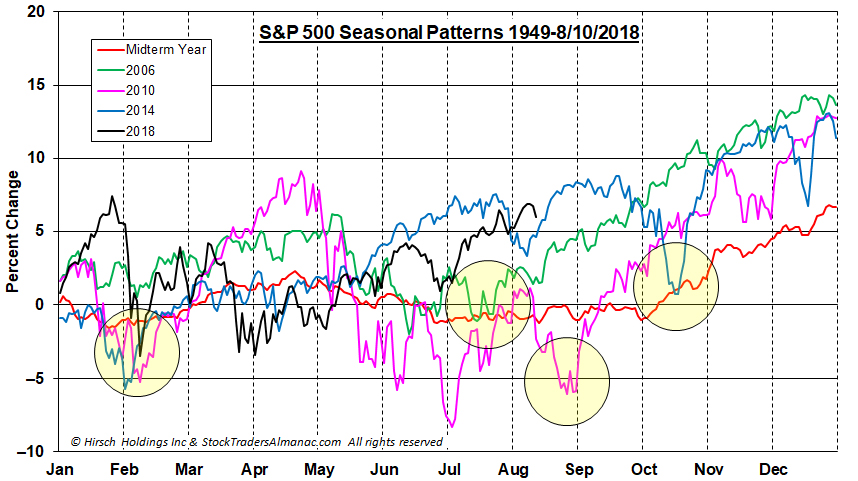While we are naturally concerned about the market’s lofty levels, climbing bullish sentiment and the seasonally bearish tendencies of September, we expect the market to continue on its bullish trajectory save for a dip toward the end of August and then again at the end of Q3 and early October. The market will eventually selloff, but we don’t expect any major decline or bear market until next year.
Midterm years are notoriously a rough year for markets as presidents push through their most disruptive policy initiatives and battle the opposition party to retain congressional seats. But the last three midterm years, 2006, 2010 and 2014 have been strong followed by troubled pre-election years. 2007 brought us the major top of the Financial Crisis with the S&P up 3.5%. 2011 suffered a mini-bear from April to October that shaved 19.4% off the S&P, which ended the year down a fraction -0.003%. Another mini-bear transpired in 2015 with the S&P losing 14.2% from May 2015 to February 2016. The S&P finished 2015 off -0.7% for the year.
From the chart below comparing 2018 to the previous three midterm years 2006, 2010 and 2014, it looks like we are setting up for above average midterm year market gains again followed by a weaker pre-election year prone to a bear market and a recession. Encircled in yellow, all four years suffered early-year declines in January/February. Looking forward from here the previous three midterm years had pullbacks that ended in July or August or September/October as was the case in 2014.

Contagion from the economic, currency and political crisis in Turkey has not spread as of yet, but we are reminded of the 1997-98 currency crisis that started with the Thai baht meltdown in July 1997 and then spilled over into other Asian currencies in the fall of 1997. But it wasn’t until August 1998 when additional pressure from the Russian financial crisis caused the collapse of hedge fund behemoth Long Term Capital Management that had to be bailed out by Wall Street banks under the supervision of the Federal Reserve to prevent a deeper crisis.
Earnings season is winding down and has been well above estimates, again. This has buoyed the market, but the advance/decline lines are not robust, and traders and investors are complacent. VIX is back down under 14 today.
Investors Intelligence Advisors Sentiment has bulls back up to 57.3% vs. 18.4% bears, pushing the spread close to the danger zone. Weekly CBOE Equity-Only Put/Call ratio remains sanguine at 0.64.
This sets up the market for possible retracement of recent gains. But without a meaningful retreat or pullback, the Q4 rally could be muted and make us more vulnerable to an early 2019 top. Earnings comparisons will be much more challenging next year and tax cut and fiscal stimulus effects will begin to fade.
The wall of worry is not that tall. There is not much left to climb. Nothing negative has yet to stick to this White House and now it is reported that China is coming to visit later this month for renewed trade talks. China seems to be in trouble with the tariffs, the yuan has been slipping and the Shanghai composite is down 17% YTD.
The bottom line right now, whether you like it or not, is that President Trump’s “Art of the Deal” policies are trumping bearish seasonality. Everyone has been on the weak August seasonality bandwagon for some time and that trade is a little too crowded right now for any bear to emerge. The biggest midterm election surprise would be for the Republicans to not lose a bunch of seats. The Fed will most likely hike rates again in September. The Fed is still the big concern.
Pulse of the Market
DJIA’s “Hot July” (+4.7%) extended until its recent peak on August 6. Since that time, DJIA has been struggling to find traction and regain positive momentum. Prior to today’s gain, DJIA’s trend had it on course back towards and likely below its 50- and 200-day moving averages (1) where it has spent much of this year. Both the faster and slower moving MACD indicators applied to DJIA are currently negative (2) confirming the shift in momentum.
Over the last three weeks, DJIA has gone on to log two additional Down Friday/ Down Monday (DF/DM) warnings (3). The last time DJIA had a cluster of DF/DM like this (three in four weeks) began in March 2017. DJIA, S&P 500 and NASDAQ all slipped lower during the following two weeks, but then resumed their march higher as deregulation and expectations for corporate tax cuts buoyed earnings forecasts. However, the three out of four DF/DM cluster in May 2015 ultimately marked the start of a mini-bear market that lasted until February 2016.
Until last week, DJIA and S&P 500 (4) had logged five straight weekly gains. NASDAQ (5) did not participate in the streak. Divergences like this are not entirely bearish, but they also are not all that bullish.
Market breath has remained mixed with NYSE Weekly Advancers out numbering NYSE Weekly Decliners in just two of the last five weeks (6). Last week’s slightly negative breadth was accompanied by a minor NASDAQ gain and six weeks ago all three indexes advanced solidly, but breadth was negative. Weekly New Highs and New Lows (7) continue to fluctuate with no clear trend for any meaningful duration of time. Expanding numbers of New Highs and shrinking number of New Lows is usually the trend of a healthy bull market.
30-year Treasury bond yields (8) have bounced back above 3% after spending four weeks below it and the 90-day Treasury climbed above 2% last week for the first time since February 2008. 2% is still low, but after spending more than a decade below that level it could still be an issue especially if the yield curve continues to flatten.
Click image to view full size…